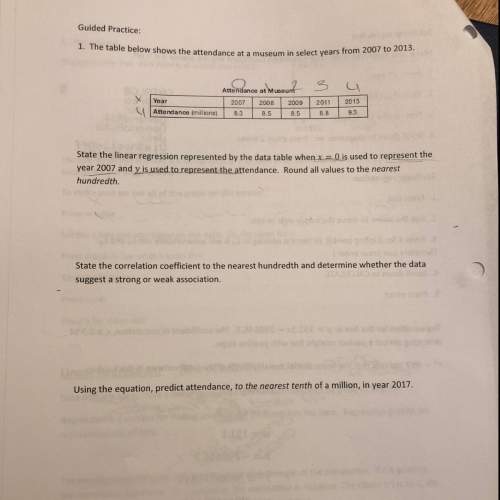
Mathematics, 14.06.2021 15:30 JeroMii
In a manufacturing process the assembly line speed (feet per minute) with thought to affect the number of defective parts found during the inspection process. To test this theory, managers devised a situation in which the same batch of pots was inspected visually at a variety of line speeds. They collected the following data.
Line Speed Number of defective parts found
20 21
20 19
40 15
30 16
60 14
40 17
Required:
a. Develop the estimated regression equation that relates line speed to the number of defective parts found.
b. At α= 0.05 level of significance, determine whether line speed and number of defective parts found are related.
c. Did the estimated regression equation provide a good fit to the data?
d. Develop a 95% confidence interval to predict the mean number of defective parts for a line speed of 50 feet per minute.

Answers: 1


Another question on Mathematics

Mathematics, 21.06.2019 21:00
When solving this problem: 3025/5.5 = a/90.75 you get 49912.5 which would be the length of one of the sides of a square when the area is only 90.75 inches. is that answer correct, why, and how is it possible?
Answers: 1

Mathematics, 22.06.2019 02:30
Atrain traveled for 1.5 hours to the first station, stopped for 30 minutes, then traveled for 4 hours to the final station where it stopped for 1 hour. the total distance traveled is a function of time. which graph most accurately represents this scenario? a graph is shown with the x-axis labeled time (in hours) and the y-axis labeled total distance (in miles). the line begins at the origin and moves upward for 1.5 hours. the line then continues upward at a slow rate until 2 hours. from 2 to 6 hours, the line continues quickly upward. from 6 to 7 hours, it moves downward until it touches the x-axis a graph is shown with the axis labeled time (in hours) and the y axis labeled total distance (in miles). a line is shown beginning at the origin. the line moves upward until 1.5 hours, then is a horizontal line until 2 hours. the line moves quickly upward again until 6 hours, and then is horizontal until 7 hours a graph is shown with the axis labeled time (in hours) and the y-axis labeled total distance (in miles). the line begins at the y-axis where y equals 125. it is horizontal until 1.5 hours, then moves downward until 2 hours where it touches the x-axis. the line moves upward until 6 hours and then moves downward until 7 hours where it touches the x-axis a graph is shown with the axis labeled time (in hours) and the y-axis labeled total distance (in miles). the line begins at y equals 125 and is horizontal for 1.5 hours. the line moves downward until 2 hours, then back up until 5.5 hours. the line is horizontal from 5.5 to 7 hours
Answers: 1

Mathematics, 22.06.2019 05:00
In physics, if a moving object has a starting position at so, an initial velocity of vo, and a constant acceleration a, the the position s at any time t> o is given by: s = 1/2 at ^2 + vot+so solve for the acceleration, a, in terms of the other variables. for this assessment item, you can use^to show exponent and type your answer in the answer box, or you may choose to write your answer on paper and upload it.
Answers: 1

Mathematics, 22.06.2019 05:00
The blue lake trail is 11 1/2 miles long.grace has hiked 1 1/2 for 2 hours. how far did she from the end of the trail
Answers: 1
You know the right answer?
In a manufacturing process the assembly line speed (feet per minute) with thought to affect the numb...
Questions

Mathematics, 18.03.2021 02:40

Social Studies, 18.03.2021 02:40

Mathematics, 18.03.2021 02:40


Chemistry, 18.03.2021 02:40

Mathematics, 18.03.2021 02:40



Mathematics, 18.03.2021 02:40

Mathematics, 18.03.2021 02:40

Mathematics, 18.03.2021 02:40

Mathematics, 18.03.2021 02:40

Mathematics, 18.03.2021 02:40


Mathematics, 18.03.2021 02:40


Mathematics, 18.03.2021 02:40

History, 18.03.2021 02:40





